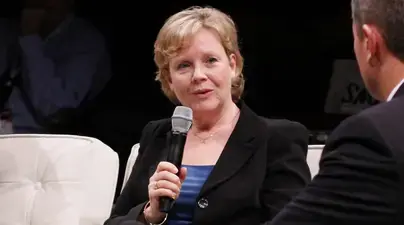From an early age, Vicki Hildebrand demonstrated an aptitude for math and physics. She studied electrical engineering in college and quickly found a role in software and hardware development at HP. “I had a job offer from every single company I talked to because there were so few women out there applying for jobs,” she recalls.
Hildebrand would build a three-decades-long career in R&D and IT, creating breakthrough products. But she aspired for more — specifically, to become a Chief Information Officer. “Technology leaders are no longer what's being sought after. Companies want business leaders,” she says. That belief led Hildebrand to Columbia’s Technology Management Executive M.S. program.
In 2016, Vicki Hildebrand earned her Columbia degree. She has held senior executive roles at top organizations ever since, including Vice President at HP Enterprise, CIO at the U.S. Department of Transportation, VP and CIO of Blue Cross Blue Shield of Vermont, and as of February 1, Senior VP and CIO of Blue Cross Blue Shield of Massachusetts. Hildebrand spoke about how her Columbia experience continues to contribute to her career trajectory, what she’s learned as a CIO during the pandemic, and how she’s giving back to the Technology Management program.
How did Columbia’s Executive M.S. in Technology Management program play a role in your career advancement?
Columbia's Technology Management program provided a complete reboot of my career. The program introduced me to the most modern leadership skills and empowered me to position myself as a business leader. The networking continues to be a key feature well after graduation. Ultimately, it was a Technology Management program connection that led me to my first CIO role.

Vicki Hildebrand spoke at the 2018 FedTalks conference in Washington, D.C., featuring executive leaders in tech and government. (Photo Credit: FedScoop.com)
Tell us about your involvement in Columbia’s Technology Management program now.
I've been working as a Course Associate with Craig Cuyar to help teach Operations Management in IT and with Steve Bandrowczak on Leading Disruptive Change in a Digital Economy. Any time you're working with Craig, CIO of Omnicom, and Steve, President and COO of Xerox, you're learning. But the most rewarding part of being an Associate is the interaction with the students. It's fun to learn from the students; I enjoy helping them find answers to their questions and the lively discussions. Many of the students proactively set up mentoring calls and reach out for assistance as they plan their careers; it’s a gratifying, full-circle moment to be able to share advice with them.
Many of the students proactively set up mentoring calls and reach out for assistance as they plan their careers; it’s a gratifying, full-circle moment to be able to share advice with them."
A year into the pandemic, what has emerged as the biggest lesson(s) learned or the best approach to managing not only consumers and clients but also your employees?
It's the Winston Churchill quote to never let a good crisis go to waste. This is the time to transform health care. We've had the opportunity to move quickly on a number of initiatives because we’ve had to be fast. There is no reason to revert back to more complexity and to reduce speed. We're asking our employees to question the value of everything they're doing and if it doesn't bring value, to help eliminate it. If what they are doing is manual, help us automate it. If we drive simplicity and speed, and focus on what our members really need, we can use this opportunity to make significant and permanent changes.
How can business leaders use technology to provide better support and flexibility for employees with children?
Before I joined the U.S. Department of Transportation, I was a teleworker for 27 years at HP — long before COVID-19. I've always advocated for custom work solutions to help people manage their work and home responsibilities. As a mom of two boys, the flexibility to telework made a tremendous difference for me. I was lucky to be supported by leaders and a company that believed in managing by performance and not by location or by hours. Some positions require more structure, but many positions in technology lend themselves to flexible hours. Ultimately, a combination of telework, flexible hours, and being in the office for critical meetings should provide the best balance and productivity for the employee and the company.
I recently had a recruiter tell me that most companies prefer to hire young men to fill their CIO positions. Yet, women bring the same leadership skills to the role of CIO that they do to all of the other leadership positions. Every company today is a technology company and women are well-positioned to drive business success through technology."
What drew you to the technology sector?
When I was in school, I was proficient in math and physics. The teaching profession wasn't my calling. At the time that I was graduating from school, there were huge opportunities for women in engineering. Of course, there were very few women in my field of study in college, so I felt like a pioneer! I was drawn to it because it was a way to apply math and physics to real-life problems, and the opportunities for career growth were really strong. That's what drew me to technology, and when I found that I could do it, I got more and more immersed in it.
We always hear about how the tech industry is trying to attract women to the sector. What’s your take on the issue?
This has been a problem for as long as I can remember. When I started my career, I had a job offer from every single company I talked to because there were so few women out there applying for technology jobs. Organizations were actively recruiting women, but women weren't jumping in. It's still difficult to attract women to technology because I think not all women are interested in the subject matter, but also because women and girls need to see and hear about more women in leadership roles. I think the reason that it's getting more publicity now is particularly because there are now a few role models out there, women who are leading technology companies. There have been a number of well-known women in senior leadership roles at technology companies such as Meg Whitman, Safra Catz at Oracle, Ginni Rometty, and Sheryl Sandberg at Facebook. These women have been incredible role models. However, most women in senior leadership roles have ascended to their positions through organizations outside of technology. There have been very few women filling Chief Information or Chief Digital Officer positions. It's been heartening to see an increase in the past few years, such as Wendy Pfeiffer at Nutanix. I recently had a recruiter tell me that most companies prefer to hire young men to fill their CIO positions. Yet, women bring the same leadership skills to the role of CIO that they do to all of the other leadership positions. Every company today is a technology company and women are well-positioned to drive business success through technology.


